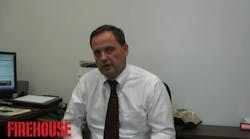EMS medical directors have had little guidance in the past about their role, their system, and even EMS culture – especially fire-based EMS culture - but several groups have now filled this void with an official beginner’s handbook.
The USFA, DHS Office of Health Affairs and the IAFC have developed the “EMS Medical Directors Handbook,” which they describe as a sort of “101” or “care and feeding of the medical director,” to define the responsibilities and limitations of this position. The goal is to enhance the medical director’s relationships with EMS system leaders and in the end, improve patient care.
Representatives of each group promoted the handbook at Fire-Rescue International in Denver last week in a session presented by Gary Ludwig, Deputy Chief, Memphis (TN) Fire Department; Rick Patrick, DHS Office of Health Affairs; and Lori Moore-Merrell, Assistant to the General President, IAFC.
The need for such a resource was identified by the IAFC EMS Section more than a decade ago, Patrick said, and the USFA was able to secure funding through a partnership with the DHS. The project got underway in 2010 and is now available for viewing and printing as a pdf from the IAFC and USFA websites. The IAFC’s page just went live last week at iafc.org/EMSmedicalDirectors.
The representatives stressed that the handbook is for directors of all types of systems – fire-based, private and third-service - and said it addresses the many pitfalls of the medical director position. These include it often being a part-time position or a position that is assigned and not a choice.
Many have no idea what they are about to undertake, Moore-Merrell said; for example, that there will be political aspects of needing to weigh in on proposed cuts, privatization, etc., and facing public scrutiny on their positions.
The handbook includes everything from square one - a history of EMS, an explanation of the various modern EMS system formats, staffing and resource deployment, dispatch, etc. It goes on to “becoming a medical director” which includes the responsibilities, expectations, safety concerns, etc. It also gets into agency dynamics and administrative logistics such as credentialing and compliance.
Resources include a checklist, glossary of EMSterms, acronyms, sample organizational charts, sample affiliation agreements, sample liability forms, industry regulations and standards, and performance standards.
Moore-Merrell pointed toward some of the most pertinent topics in the handbook, including discipline. She noted that there is often misunderstanding about the level of authority of a medical director and that there are examples in which they have dangerously overstepped their boundaries, for example, by trying to pull the certification of a responder, which only the state can do. “Discipline is always contentious,” she said, “and the role needs to be defined with written policies.”
She said the handbook also highlights the need to bridge the gap between hospital-based emergency medicine and EMS in the field, and that the most successful directors – especially of fire-based systems – understand it and build relationships by spending time and riding with the personnel.







